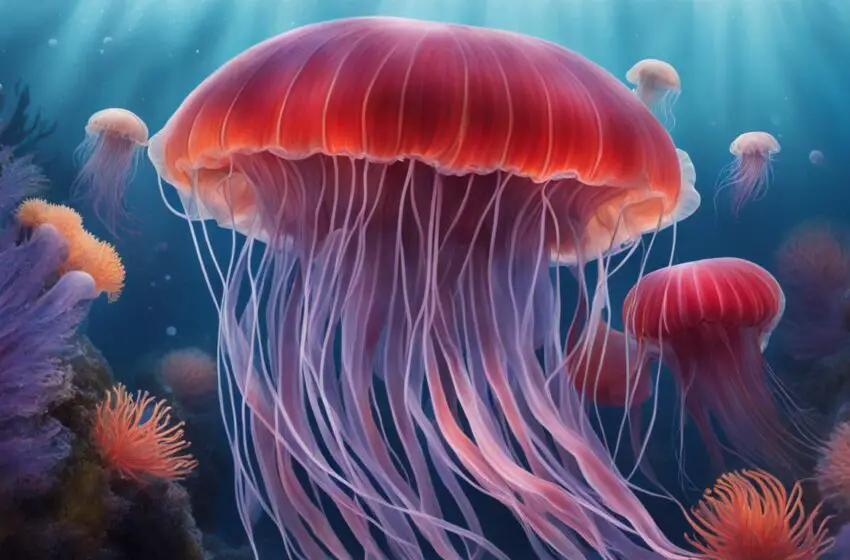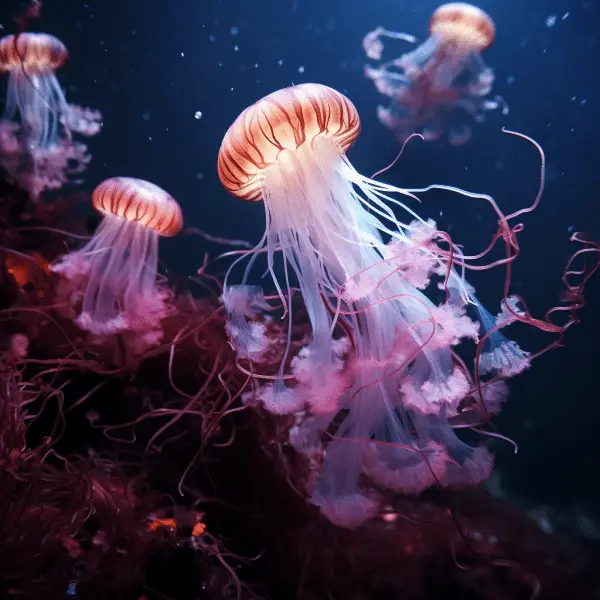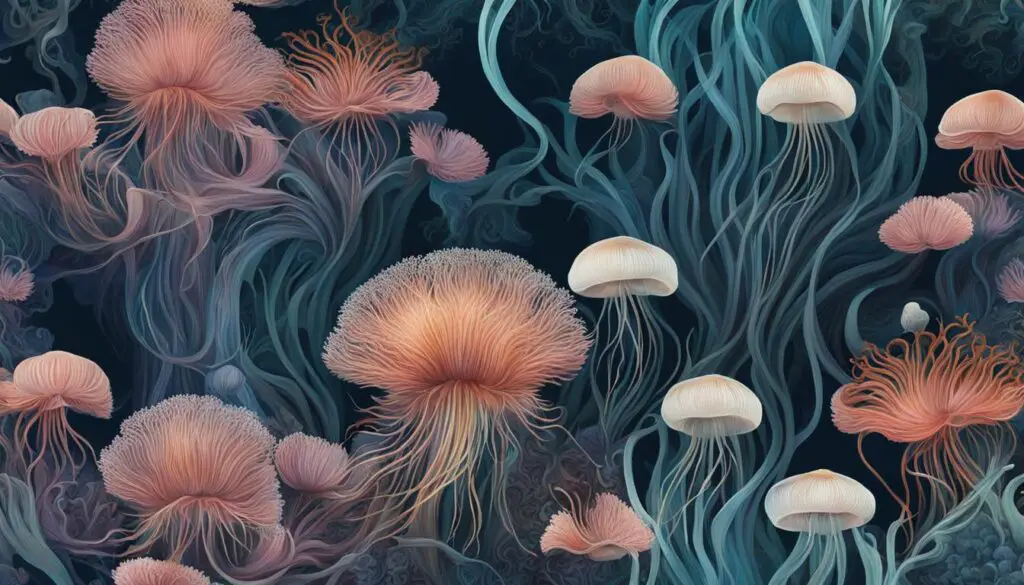Anemones Vs. Jellyfish: Contrasts And Marvels In The Ocean

Anemones and jellyfish are both fascinating creatures that inhabit the underwater realm. While they share certain characteristics, they also have distinct differences. Here, we will explores the similarities and differences between anemones and jellyfish, shedding light on their features, characteristics, taxonomy, behavior, habitat, and feeding habits.
Anemone Features and Characteristics

Anemones are marine animals that belong to the phylum Cnidaria. They typically have a cylindrical body with tentacles surrounding a central mouth. Anemones are sessile creatures, meaning they are attached to a substrate and do not move around like jellyfish. They have a soft, gelatinous body and come in a variety of colors, including vibrant shades of red, orange, and green. Anemones have specialized cells called cnidocytes, which contain stinging structures called nematocysts that they use for defense and capturing prey. They often form symbiotic relationships with clownfish, providing protection to the fish while benefiting from the nutrients that the fish provide.
Jellyfish Features and Characteristics
Jellyfish, also known as medusae, are another type of marine animal belonging to the phylum Cnidaria. They have a bell-shaped body with long, trailing tentacles and a central mouth. Unlike anemones, jellyfish are free-swimming creatures and have the ability to move through the water using pulsations of their bell-shaped body. Jellyfish come in various shapes, sizes, and colors, ranging from small, transparent species to larger, colorful ones like the moon jellyfish. They have cnidocytes and nematocysts like anemones, which they use to capture prey and defend themselves.
Conclusion
In conclusion, anemones and jellyfish are fascinating creatures with unique features and characteristics. Anemones are sessile animals that form symbiotic relationships with clownfish and have specialized stinging cells called cnidocytes. Jellyfish, on the other hand, are free-swimming animals that use pulsations of their bell-shaped body to move through the water. While they both belong to the phylum Cnidaria and share some similarities, their differences in behavior, mobility, and habitat set them apart. Understanding these differences enhances our knowledge and appreciation of the diverse life forms found in nature’s underwater realm.
Key Takeaways:
- Anemones and jellyfish are marine animals that belong to the phylum Cnidaria.
- Anemones are sessile creatures, while jellyfish are free-swimming.
- Anemones have specialized stinging cells called cnidocytes, while jellyfish use pulsations of their bell-shaped body to move.
- Anemones often form symbiotic relationships with clownfish, providing protection to the fish.
- Understanding the differences between anemones and jellyfish enhances our knowledge of underwater biodiversity.
Anemone Features and Characteristics
Anemones are intriguing aquatic organisms with distinct traits. These Cnidaria have cylindrical bodies with tentacles around a central mouth. Anemones lie on a substrate and cannot move like jellyfish.
Anemones use their fragile, gelatinous bodies to change their form and catch prey. They are beautiful in underwater habitats because to their bright red, orange, and green colors.
Anemones have cnidocytes with nematocysts. Anemones use these powerful nematocysts to defend and attack. Nematocysts produce harpoon-like structures that inject venom into their targets, immobilizing or killing them. Anemones may defend their territory with this talent.
Anemones’ ability to create symbiotic connections with clownfish is remarkable. The anemone protects the clownfish, while the fish gives nourishment and protection from predators. This unique alliance shows marine ecosystems’ complex interdependencies.
| Key Features and Characteristics of Anemones | |
|---|---|
| • Cylindrical body shape with tentacles | • Soft, gelatinous body |
| • Vibrant colors (red, orange, green, etc.) | • Specialized cells called cnidocytes |
| • Stinging structures called nematocysts | • Sessile behavior |
| • Symbiotic relationships with clownfish |
Understanding the unique features and characteristics of anemones provides valuable insights into the complexity and diversity of marine life. These fascinating creatures showcase the remarkable adaptations and interdependent relationships that exist within the underwater realm, captivating the curiosity and awe of both scientists and nature enthusiasts alike.

References:
- “Anemone.” National Geographic Society.
- “Cnidarians.” MarineBio Conservation Society.
- “Clownfish and Anemone Mutualism.” The Wildlife Trusts.
Anemone and Jellyfish Features and Characteristics
When comparing anemones and jellyfish, it’s essential to understand the unique features and characteristics that distinguish these fascinating creatures.
Anemone Features
Anemones, belonging to the phylum Cnidaria, have a cylindrical body with tentacles surrounding a central mouth. They are sessile creatures, meaning they are attached to a substrate and do not move like jellyfish. Anemones come in vibrant colors such as red, orange, and green, adding beauty to the underwater environment. One of their distinguishing features is the presence of specialized cells called cnidocytes, which contain nematocysts, the stinging structures they use for defense and capturing prey. These remarkable creatures often form symbiotic relationships with clownfish, providing protection to the fish while benefiting from the nutrients provided by the fish.
Jellyfish Features
Jellyfish, also known as medusae, are another type of marine animal belonging to the phylum Cnidaria. They have a bell-shaped body with long, trailing tentacles and a central mouth. Unlike anemones, jellyfish are free-swimming creatures and have the ability to move through the water using pulsations of their bell-shaped body. Jellyfish come in various shapes, sizes, and colors, from transparent species to larger, colorful ones like the moon jellyfish. Like anemones, jellyfish possess cnidocytes and nematocysts, which they use for capturing prey and defending themselves.
Comparison Table: Anemone vs. Jellyfish Features
| Features | Anemones | Jellyfish |
|---|---|---|
| Mobility | Sessile, attached to a substrate | Free-swimming |
| Body Shape | Cylindrical | Bell-shaped |
| Tentacles | Surround the central mouth | Long, trailing tentacles |
| Movement | Immobile | Pulsations of bell-shaped body |
| Color | Vibrant shades of red, orange, and green | Various colors, including transparent and colorful species |
| Symbiotic Relationships | Often form relationships with clownfish | N/A |
Understanding the features and characteristics of anemones and jellyfish helps us appreciate the diversity of life in the underwater realm. While anemones are sessile creatures with vibrant colors and symbiotic relationships, jellyfish are free-swimming animals that rely on pulsations to move and come in various shapes and sizes. Both anemones and jellyfish possess cnidocytes and nematocysts, which are vital for their survival in their respective habitats.
Image source: https://seo writing.ai/32_6.png
Conclusion
In conclusion, the comparison between anemones and jellyfish reveals fascinating insights into these unique creatures of the underwater realm. Anemones, with their sessile lifestyle and symbiotic relationships with clownfish, showcase the beauty of their cylindrical bodies adorned with vibrant colors. Their cnidocytes and nematocysts serve as defense mechanisms and tools for capturing prey, making them formidable predators in their habitat.
Jellyfish, on the other hand, mesmerize with their graceful movements and bell-shaped bodies. Their ability to swim freely through the water, propelled by pulsations, sets them apart from their stationary counterparts. With an array of shapes, sizes, and colors, jellyfish epitomize the diversity found in the oceans, ranging from translucent species to the enchanting moon jellyfish.
While anemones and jellyfish share similarities as members of the phylum Cnidaria, their differences in behavior, mobility, and habitat contribute to their distinct identities. This comparison deepens our understanding of the intricate ecosystems in which they thrive and enriches our appreciation for the wonders of nature’s underwater realm. Exploring the anemone vs jellyfish dichotomy enhances our knowledge and fosters a sense of fascination for the diverse life forms that exist beneath the waves.
FAQ
What are the main differences between anemones and jellyfish?
Anemones are sessile creatures that are attached to a substrate, while jellyfish are free-swimming animals. Anemones have a cylindrical body with tentacles surrounding a central mouth, while jellyfish have a bell-shaped body with long, trailing tentacles. Anemones often form symbiotic relationships with clownfish, whereas jellyfish do not.
Do anemones and jellyfish belong to the same phylum?
Yes, both anemones and jellyfish belong to the phylum Cnidaria.
How do anemones and jellyfish capture prey?
Both anemones and jellyfish have specialized cells called cnidocytes, which contain nematocysts. They use these stinging structures to capture prey.
Can anemones and jellyfish defend themselves?
Yes, both anemones and jellyfish have cnidocytes and nematocysts that they use for defense against predators.
Do anemones and jellyfish have similar colors?
Anemones come in a variety of colors, including vibrant shades of red, orange, and green. Jellyfish also come in various colors, ranging from transparent species to colorful ones like the moon jellyfish.
Are anemones and jellyfish capable of moving?
Anemones are sessile creatures and do not move, while jellyfish have the ability to move through the water using pulsations of their bell-shaped body.
Do anemones and jellyfish have any similarities?
Anemones and jellyfish both belong to the phylum Cnidaria and have cnidocytes and nematocysts. They also share the ability to capture prey using these specialized cells. However, their differences in behavior, mobility, and habitat set them apart.
Can anemones and jellyfish be found in the same habitat?
Anemones are typically found attached to substrates in marine environments, such as coral reefs and rocky shores. Jellyfish, being free-swimming creatures, can be found in various marine habitats, from coastal waters to open oceans.



